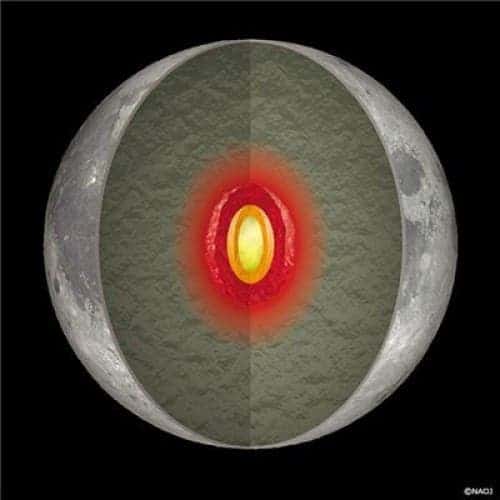A new study has shown that there is still an extremely hot layer deep inside the moon, with heat generated by the gravity from the Earth. If this is indeed the case, then the inside of the Moon has not yet entirely solidified, providing an insight on to how the Earth-Moon system evolved.
There is still a lot of debate regarding the Moon’s nature – is it a true satellite, or is it in fact a planet of its own, trapped by the Earth’s gravity system? When discussing the nature of such a celestial planet, you must understand how it was born and how it evolved. But studying the early stages and evolution of the Moon is no easy feat, and that’s why researchers were thrilled to find this hot layer. But how do you “find” a hot layer in the depths of the Moon? The key here is gravity.
We can get a good indication of what’s happening inside a celestial body by studying slight modifications in its shape. The shape of a celestial body being changes by the gravitational force of another body is called tide; we see this on Earth, in the oceans. High and low tides occur mostly due to the Moon’s gravity (the Sun also plays a smaller role), because water is so deformable that its desplacement can be easily observed. But even the solid parts can be displaced, though to a much smaller extent. Observing the degree of deformation enables us to infer several things about the interior.
But there are more ways to study the internal structure. When the Apollo program landed people on the Moon, they also left seismological sensors on the surface – because the Moon also has earthquakes (perhaps moonquakes would be more accurate though). Through these sensors, they showed that the satellite has two main parts: the “core,” the inner portion made up of metal, and the “mantle,” the outer portion made up of rock. Based on this data, and previous shape deformation observations, Dr. Yuji Harada and his team managed to show that there is also an intermediate, hot layer, wrapping and warming the core. But this study, while it may very well revolutionize what we know about the moon, it actually poses more questions than it answers, researchers say:
“I believe that our research results have brought about new questions. For example, how can the bottom of the lunar mantle maintain its softer state for a long time? To answer this question, we would like to further investigate the internal structure and heat-generating mechanism inside the Moon in detail. In addition, another question has come up: how has the conversion from the tidal energy to the heat energy in the soft layer affected the motion of the Moon relative to the Earth, and also the cooling of the Moon? We would like to resolve those problems as well so that we can thoroughly understand how the Moon was born and has evolved.”
Another investigator, Prof. Junichi Haruyama of Institute of Space and Aeronautical Science, Japan Aerospace Exploration Agency also emphasizes the significance of this study:
“A smaller celestial body like the Moon cools faster than a larger one like the Earth does. In fact, we had thought that volcanic activities on the Moon had already come to a halt. Therefore, the Moon had been believed to be cool and hard, even in its deeper parts. However, this research tells us that the Moon has not yet cooled and hardened, but is still warm. It even implies that we have to reconsider the question as follows: How have the Earth and the Moon influenced each other since their births? That means this research not only shows us the actual state of the deep interior of the Moon, but also gives us a clue for learning about the history of the system including both the Earth and the Moon.”
Scientific Reference: Yuji Harada, Sander Goossens, Koji Matsumoto, Jianguo Yan, Jinsong Ping, Hirotomo Noda, Junichi Haruyama. Strong tidal heating in an ultralow-viscosity zone at the core–mantle boundary of the Moon. Nature Geoscience, 2014; 7 (8): 569 DOI: 10.1038/ngeo2211










